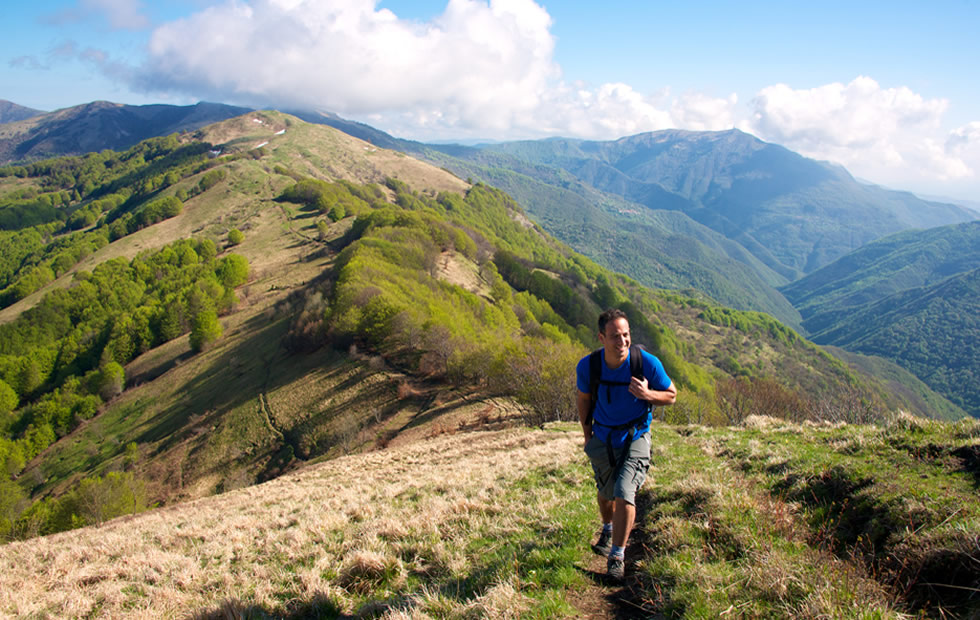Aaron Miller embarks on a solo hike along Liguria’s historic Old Salt Road
Sometimes the wrong path is the best path. I was stumbling down the
side of a steep mountain slope, pushing through thorny bushes, scratched, thirsty and utterly confused. But I was smiling. While walking the Old Salt Road – an ancient trade route across the Ligurian hills in northwest Italy – I had become hopelessly lost.
But as I was cursing my lack of navigational instinct something magical happened. I rounded a corner into a mountain meadow filled with dozens of wild horses – muscled stallions with jet black manes, gold skinned mares and tiny foals still suckling on their mother’s milk. Startled at first, they soon found themselves more curious than afraid and gradually came to graze by my side. It took me half a day to find my way back again, but it was worth every cut and bruise. The best adventures always happen when you least expect it.
But walking the Salt Road isn’t just an adventure; it’s a part of history. For more than a thousand years, mule herders carrying precious salt from the ports of Liguria would traverse this network of trails over the Apennine mountains to trade with the fertile plains of Lombardy, returning laden with wheat, wine, salami and cheese. Their footsteps have now all but vanished, but that may be set to change. A new trip is enabling people to walk the Salt Road again and, in doing so, it’s opening up a part of Italy that few tourists have explored.
By following the route for 129 km (80 miles), from Oltrepò Pavese, just north of Genoa, to the small port of Camogli in Liguria, I hoped to help re-establish that ancient legacy and discover, along the way, an authentic glimpse of rural Italy: fiercely traditional, defiantly unglitzy and full of genuine welcome and honest heart.
The route begins in rolling fields of Pinot Noir and Bonarda grapes. Oltrepò Pavese is the largest wine-growing area in Lombardy and every available space
is filled with parallel rows of black root vines and the gentle bustle of worked land. I walked for two days through tiny terracotta hamlets and small peach farm holdings to reach Varzi, a snug valley
town that was once an important
stopping point on the Salt Road. In the narrow alleyways of the old section,
nestled between the faded facades of medieval monasteries and dry-stone witches’ towers, it’s still possible to see
the cavernous holds under houses where traders would have set up their market stalls.
From there I climbed steeply into the Apennines, following a high panoramic ridge line south for three days, the mountains empty and silent but for the disappearing canter of deer hooves and the woody clatter of cowbells unseen in clouded valleys below. At the summit of Monte Carmo I shared the dawn with a dairy farmer and his herd – the only other person I saw walking the trail. From the top of Monte Antola – where Einstein famously camped out as a teenager while hiking part of the Salt Road – I could just make out the snow on the Alps in the north and the sun on the Mediterranean to the south. The Apennines may just be Italy’s best-kept secret.
the Real Italy
Deeper into the mountains, the hospitality became even more delicious, too. At the sleepy mountain lodge Capanne di Cosola – once the centrepiece of partisan resistance during the Second World War – I ate hand-picked wild mushrooms and four individual plates of pasta before my main course even arrived. At the eco-farm Villa Tiffany we laughed through an entire three-course dinner of stuffed calamari and gnocchi pesto using only Google Translate. “The secret of great cooking,” owner Francesca typed into the screen, “is the water. Here, we have mountain springs so everything tastes good.”
On my last day, belly full and legs tired, I climbed down to the lower Ligurian hills of the Uscio Valley. Small wooden fishing boats sailed into the vastness of the Mediterranean as a sea mist drifted up from the coast beneath me. I had reached the end of the Old Salt Road.
That night in the cute, multi-coloured port of Camogli, they would celebrate the annual Sagra del Pesce, an eccentric local fish festival that involved religious processions, burning effigies and free fish risotto. But I couldn’t stop thinking about those mule herders. When I was lost on the mountain I had a glimpse of what their arduous journey must have been like. And now, having arrived at the end of the road, they would have had to restock on salt, turn around and do it all over again.
Thankfully, I had it much easier. I wandered Camogli’s medieval streets, ate ice cream on the harbour wall and let the real, traditional Italy wash over me. Sometimes the best path is the path you’ve just finished walking.
